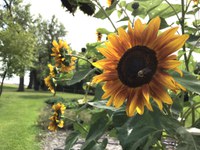Dakota Gardener: Mystery plant No. 2
(Click an image below to view a high-resolution image that can be downloaded)
By Carrie Knutson, Horticulture agent
NDSU Extension – Grand Forks County
Last year, I grew okra as a mystery vegetable in my school garden program. The idea was to introduce young gardeners to a new vegetable and get them to try it. The gardeners did have a hard time guessing the name of the plant.
I was worried the pods would not be picked, and that the pods would get old and be left on the plant. That was not the case. The young gardeners kept the pods harvested, and I didn’t even get a chance to try the okra!
The okra was well cared for thanks to a NDSU Extension Master Gardener who cares for the garden and helps me teach the young gardeners. The flowers were a beautiful addition to the garden and the plant regularly produced pods. The plant grew to about 2 feet tall.
The mystery plant was such a success that it will be part of my gardening programs this year. This year’s mystery plant might not be such a mystery to you. Let’s see if you can guess what the mystery plant is or at least learn something new about the plant by the end of my column.
The mystery plant is an annual native to North America. The flowers come in a range of colors from deep reds and browns to white. Some are even bicolored. The mystery plant prefers full sun and is tolerant of most soil types. It can handle dry conditions but will do better in garden settings with supplemental watering.
The mystery plant prefers to be direct seeded as it doesn’t like for its roots to be disturbed. If you choose to start seeds indoors, use biodegradable paper pots. Gardeners can grow pollenless, single stem, branching, dwarf and giant varieties. Spacing of the plants depends on the variety.
The leaves of the mystery plant are thick and are usually covered with short hairs. Sometimes the leaves will feel rough against your skin. The stem is strong and sturdy.
The flower is a composite flower made of individual ray and disc flowers. Immature flowers will follow the sun, but mature flower heads will face east. The flowers will attract many beneficial insects and pollinators.
The flowers can be used in fresh or dried arrangements. Gardeners and wildlife alike will enjoy snacking on the seeds. Gardeners might have to protect the plant to prevent other wildlife from harvesting the seeds before they are ready.
In agriculture, two main types are grown. They are oil and confection types. According to the U.S. Department of Agriculture’s National Agricultural Statistics Service, in 2022, North Dakota ranked No. 1 in the U.S. for production of this mystery plant. North Dakota grew more than 1.3 billion pounds.
Did you figure it out or learn something new about this plant? This year’s mystery plant is a sunflower. Add it to your landscape this summer so you and the local wildlife can enjoy its benefits.
Happy gardening!
NDSU Agriculture Communication – March 7, 2024
Source: Carrie Knutson, 701-780-8229, carrie.knutson@ndsu.edu
Editor: Kelli Anderson, 701-231-7006, kelli.c.anderson@ndsu.edu




